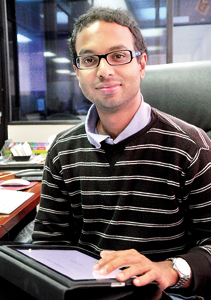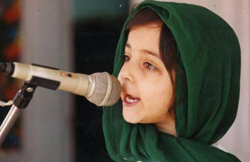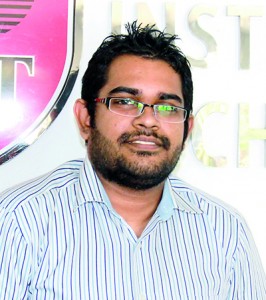Coming back home with two wonder apps at his fingertips
In late 2011, a 28-year-old Sohan Dharmaraja was just wrapping up his PhD thesis in Computational Mathematics at Stanford University in the US. With a Masters from MIT (Massachusetts Institute of Technology) in the subject already under his belt, his current interest was in how excruciatingly accurate high fidelity real world simulations could be played out on computers – if you crashed a hypothetical Prius into a wall, Sohan could predict how the car’s frame would warp and its windshield shatter.
By the beginning of 2012 though, Sohan’s life was markedly different. Having moved back to live and work here, he was in the process of shepherding one mobile phone application into its final form and would soon develop another.
Both apps were revolutionary in their own right: One is a dazzlingly efficient trilingual chatting system that can also be used to teach users a language’s alphabet, the other, developed in collaboration with Adrian J. Lew, an assistant professor in Stanford’s mechanical engineering department and Adam Duran, NMSU undergraduate, is set to transform the way the visually impaired interact with technology. Sohan went in to both projects largely ignorant of the technical failings of Braille writers or the intricacies of the Tamil script, but the one thing he was certain of was that he wanted to develop the technology here, in Sri Lanka.
“I’m not very good with electronics, I’m not a software guy, I’m not a human-computer interaction guy, I’m not a disabilities expert or anything – but I think the reason the contribution came out was because of the new perspective I could bring to the problem,” says Sohan, who believes all the years of predicting material behaviour and response inspired a different approach, one that has paid off.
There’s an electronic device wherever you look on Sohan’s desk in his offices off Galle Road. Selecting a phone and a computer from among them, he demonstrates his trilingual app. He designed it for the HackAnDroid Sri Lanka 2012 competition (the winners are yet to be announced) and the one caveat was that the app address a burning issue in modern Sri Lanka.
 Software for the blind: The keyboard with eight dots that facilitates accurate typing. |
 Sohan |
“What we settled on was something to address the post-war language problem,” says Sohan, explaining that developers are often challenged by the sheer size of the alphabet in the local languages. The numbers of letters in the English alphabet (26) is eclipsed by those in Sinhala (52) and Tamil (247) – an impractical number to squeeze onto a digital keyboard.
So Sohan has created an app that is startlingly efficient at recognising letters hand drawn on the screen – users can train the app to match symbols of their choice to respective letters. It’s a real achievement when you consider how bewildering similar some of these letters are.
The app also serves as a fun, script teaching tool – this part is meant for young kids, but it’s a simple, interactive way to learn a new alphabet.
Without any of the bother of installing fonts or undue fuss, the app also allows for trilingual chatting. Sohan simply writes out his message on his phone and it’s seamlessly transferred to the chat client. Switching between languages, even in the same sentence, is effortless. “It’s a fully trilingual chat system,” says Sohan. The app also recognises any other app that could employ text – allowing users to post in Sinhala and Tamil to Twitter and Facebook, Myspace and WordPress or any other platform that you care to name. “It’s a very simple interface,” says Sohan who is already brimming over with ideas on how to improve it.
He’s currently working on an interface that opens up when a user selects the Sri Lankan flag on her keyboard. The screen splits to include a small space that serves as a pad where a user can simply write in the language of her choice. “It starts making the smart phone market accessible to a big group of people,” says Sohan, anticipating an ever growing number of users as touchscreen devices become increasingly affordable.
Sohan’s other app has already generated a great deal of buzz. A dozen news outlets, including the BBC and Wired reported on it when it won a competition organised by the U.S Army in late 2011. Contestants were asked to design something for a tablet device and Sohan and his team chose to focus on creating a tool that allowed a visually impaired person to type.
Currently, the blind rely on devices like Braille writers. The writers are clunky and expensive (costing as much as $6,000), but the greater crime, at least as far as Sohan is concerned, is that they can’t do much else. Tablet touch screen devices like iPads aren’t guilty of that sin – costing a fraction of the price, they can run hundreds of apps, turning the device into a multi-medium entertainment centre or a travelling office.
While some visually impaired people do use iPads, they rely on the voice over feature that reads out whatever is under their finger at that moment.
“You can type like this but can you imagine taking down lecture notes or writing an address in the street or even taking down a telephone number?” asks Sohan. “It’s actually painful but the blind community has been satisfied with this because it’s better than nothing.” However, since the smooth panes on touchscreens provide no tactile reference points, the obvious question was how do you replicate buttons on a touchscreen for a blind person?
To illustrate, Sohan reaches for an iPad, pulls off his glasses and closes his eyes. He lets his fingers rest on the screen just once and as soon as that happens, the keyboard is built beneath his fingers. Every time he touches the screen, the keyboard is rebuilt again. The keyboard consists of 8 dots. You tap the index finger on your left hand on a dot to generate the letter ‘a’, to do ‘b’ it’s a combination of the index and middle finger on your left hand, and so on. It’s a system Braille users are already familiar with and mastering it allows for quick, accurate typing. The keyboard is customised to the size of your hands, another improvement on the one-size-fits-all Braille writers.
“It’s such a simple idea, that’s why I like it so much,” says Sohan. “Some ideas are so complex that you’re sceptical about their success, but this is so simple, I feel it’s just going to work.” Developing the app meant paying attention to a whole lot of detail – one thing that became immediately apparent was a fixed keyboard wouldn’t work. A user’s fingers tended to drift as he or she became tired. “It may sound like a small thing, but it’s a huge problem,” Sohan says explaining that the solution was to design the buttons so that they moved with the users’ fingers.
Sohan and Adrian have spent the last few months working with visually impaired beta testers. “I’m just in awe of them,” Sohan confesses. “When one sense is taken away the other compensate – the way a blind person processes audio is ten times faster than you and me. I’m always learning.” The two men quickly became aware that while there were experienced iPad users among the visually impaired in the States, that wasn’t necessarily true of Sri Lanka but that while the challenges faced by each group were unique the app had the potential to really improve their interactions with modern technology.
Meanwhile, 2012 has been a full year for Sohan but he’s never second guessed his decision to move back home – he has a great deal of faith in what Sri Lankans are capable of and a sense of the country’s potential. “We have so many smart people in this country,” he says, “and I think a project like this coming out of here could really help to establish Sri Lanka as a competent authority in a really important field.”
Follow @timesonlinelk
comments powered by Disqus























